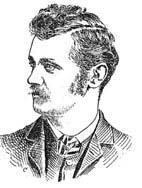The Royal Restaurant.
10-12 West Nile Street, Glasgow.
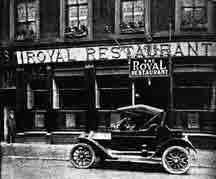
The Royal Restaurant was a famous landmark in Glasgow for over one hundred years. Established in 1853 by Charles Wilson & Son a cook and confectioner who built the Royal into one of the best places in town to dine and have a good drink. The Royal Restaurant was severely damaged by fire and reopened on 22nd September 1856. In 1875 Charles also had the Buchanan Street Station Refreshment Rooms.
In 1882 George R MacKenzie took over the business, George too was a prominent figure in the licensed trade and restaurant business in the West of Scotland. Mr MacKenzie was born in the Isle of Skye, after a life of considerable adventure in South America and India he became manager of the Shandon Hydropathic establishment. He then took over the Royal Restaurant in West Nile Street, he was well known in the city as being one of the chief caterers around, he catered for the occasion of the inauguration of the Clan Line of steamers entering into the new docks at Tilbury and the opening of the James Watt Dock at Greenock in 1886. The Pen and Pencil Club held their symposium in the Royal along with other organisations and social events, the 10th L R V (Glasgow Highlanders) also frequented here. In the 1880s the manageress was a Mrs McGregor, she ran this famous restaurant and bar along with Mr MacKenzie.
After Mr MacKenzie, William McKillop took over the restaurant. William's father was an Irishman, a mason to trade and came to Ayr with his wife Matilda to set up a family of three boys and five daughters one was a set of twins. The eldest son was John who worked as a barman in Ayr while William worked his younger days as a power loon weaver, his younger brother and sisters also worked in the cotton mills. When he lift Catrine, Ayr almost penniless he joined his brother John in the wine business, John being the senior partner. Together they owned several bars in Glasgow including premises at 46-48 Crown Street, 246-48 George Street, 104 Cornwall Street, 27 Mair Street, Plantation and 47 Kent Street, Calton. McKillop's 10 year old whisky at 10d a gill was a treat, it was advertised that it was "mellow as mother's milk, but potent withal, when doon."
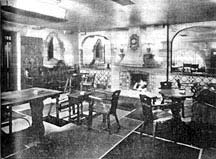
Interior views of the Spanish Lounge, Royal Restaurant. 1945.
Messrs McKillop traded here until 1905, it is interesting to note that both Messrs McKillop and George R MacKenzie, were the chief caterers for the Glasgow International Exhibition 1901.
In 1920 another well known and respected figure in the licensed trade, John Grant took control of the business. His ambition was to turn the Royal Restaurant into the most popular rendezvous in the city and to give it a character and a name that would be unique, he took in neighbouring premises and installed a new kitchen the old kitchen being transformed into a Spanish Lounge.
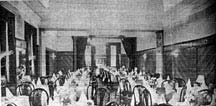
The Walnut Dining Area.
Later came the Clan Bar, shields of the main Scottish clans were fitted into the paneling, interesting features of the bar was the carvings on the counter, a replica of the decoration on the cradle of Mary Queen of Scots and a set of bagpipes carried at the battle of Culloden. Fronting the entrance of the bar was a magnificent picture of Loch Katrine and Ben Venue by Robert Houston, R.S.W., another picture was of Tom Gilfillan's Keystone of the Commonwealth painted in 1940.
In 1932 the Scots room was designed as a tribute to the fighting forces of Scotland. A Buchanan tartan carpet covered the floors and tartan curtains hung on the windows. On the walls were badges of the Scottish Divisions and an outstanding mural of a young pretender, flanked by two brawny Highlanders. The Balmoral Dining Room had pictures of Balmoral painted as a frieze, these showing the various seasons, there was also the Walnut Dining room.
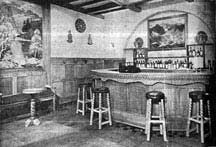
The Clan Bar, Royal Restaurant. 1945.
When John Grant died in 1945 his son D C Grant took over the business. Customers used to go into the Royal just to see some of the works of art on the walls, probably the most famous one was Tom Gifillan's picture of Prince Charlie meeting his French Generals.
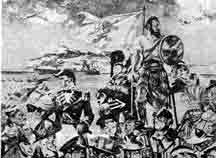
Tom Gilfillan's Keystone of the Commonwealth, one of the many murals in the Royal Restaurant. 1945.
The Royal was finally demolished in the late 1970s.
In the News June 1972...
One of Glasgow's oldest and best-known restaurants, the Royal in West Nile Street, is having a face lift. For many years a favourite meeting-place not only of Glasgow people but visitors from the US and Canada, the Royal has a tradition all its own. The very Scottish flavour of the Royal is underlined in the names of its dining-rooms and bars, Balmoral, Braemar, Regency, Clan, and so on, although the basement makes a departure with its Spanish Lounge.
But although the first phase of the reconstruction has included many up-to-date features, the tradition has been preserved. A completely redecorated entrance foyer and staircase lead to the transformed first-floor dining-room and cocktail lounge.
Kitchen in view
Formerly on the upper floor the kitchen is now a very modern and attractive open-plan affair finished attractively in blue and white decorative tiling. A very large serving hatch allows diners to watch their meals being cooked, and a special feature of the serving counter is a bank of heating lamps with copper shades which keep the food piping hot while waiting to be served.
Pride of place
The dining-room itself has been decorated in red and ivory, with red carpeting and curtains to offset the ivory and beige wall-panels framed in gilt strips. The panels are in fact the latest thing in fire-precautionary measures, being Vinyle-coated asbestos. Among the nicest features of the new dining-room are the pairs of red shaped wall lamps set at frequent intervals round the walls.
The ceiling has been lowered except at one end where a square section reveals a deep purple painted dome.
Famous Bar
Along the corridor from the dining-room the cocktail lounge sports a Stewart tartan carpet whose bright colours go well with the dark wood of the furnishings and gantry, where pride of the place has been given to a set of bagpipes actually used at Culloden and now mounted in a glass case. Pleasant background music on tape is a new departure, and it doesn't at all detract from the peaceful atmosphere.
"This is quite a famous bar," manager Mr John Birrell told me. "It's a traditional venue for Americans and Canadians, and many a nostalgic visitor comes back to reminisce over the old days, especially the war years when the Royal was a meeting place for many nationalities."
A large oil painting of stags on a mountain by a Scottish painter hangs on the staircase wall, and many an offer for it has come Mr Birrell's way. "I get letters asking to buy it from all over the world," said Mr Birrell, "but, of course, we wouldn't dream of it. I expect it's in the four-figure bracket now."
For Deaf Dumb
Downstairs the Oban Bar and the very popular Regency Bar are next in line for redecoration. The Regency in particular has become a favourite meeting place for Deaf and Dumb people, and Mr Birrell is very proud of having two of his staff able to talk to them in sign language.
Mr Birrell has been manager of the Royal, owned by Tennent Caledonian for the past six years, after a career which has taken him to Ireland, the West End of London, and the Continent. Tennent's have carried out the alteration work with their own staff, with flooring from Scott's of Oldham and tiling from Toffolo Jackson's.
Read More On Glasgow's Old Restaurant's.
End.


